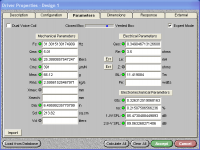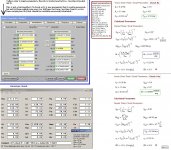You can measure Cms directly by placing a weight on the cone and measuring displacement. You can also measure VAS with various sized boxes or different masses.
You can measure Bl by placing a weight on the cone and measuring how much DC current it takes to bring it back to the unweighted condition.
Was your Re measured or extracted from the impedance? You can get a more precise Re by making a low ohms meter using a LM317 voltage regulator.
You can measure Bl by placing a weight on the cone and measuring how much DC current it takes to bring it back to the unweighted condition.
Was your Re measured or extracted from the impedance? You can get a more precise Re by making a low ohms meter using a LM317 voltage regulator.
Another idea...
b
Attachments
I am trying to get the measurement of cone displacement in real . by yours (bjorno and rons style).
but suppose i am able to get displacement, then whats next. how to calculate Cms and BL.
what extra electrical setup would be needed.
edit:
@ Ron my Re was measured using multimeter. (care was taking to eliminate probe resistance ).
but suppose i am able to get displacement, then whats next. how to calculate Cms and BL.
what extra electrical setup would be needed.
edit:
@ Ron my Re was measured using multimeter. (care was taking to eliminate probe resistance ).
Last edited:
I am trying to get the measurement of cone displacement in real . by yours (bjorno and rons style).
but suppose i am able to get displacement, then whats next. how to calculate Cms and BL.
what extra electrical setup would be needed.
edit:
@ Ron my Re was measured using multimeter. (care was taking to eliminate probe resistance ).
CMS [meters/Newton]is simply the inverse of the spring constant so if you place 200 grams (200*9.8=~2N) on the cone and it moves .003meters, your Cms is .0015 m/N
For BL, you need a variable DC voltage source, measure the current required for the weighted cone to return to the rest position, and F=m*9.8= Bl * i, solve for Bl.
You can get more significant figures on Re with a low ohms meter.
Was your Re measured or extracted from the impedance? You can get a more precise Re by making a low ohms meter using a LM317 voltage regulator.
Is it possible to be a bit more elaborate on this one, never heard of it, and I'm slowly, very slooooooooowly starting up my own project and want to be as precise as I possibly can (within reason).
- Status
- This old topic is closed. If you want to reopen this topic, contact a moderator using the "Report Post" button.
- Home
- Loudspeakers
- Subwoofers
- Driver TS crosscheck.


